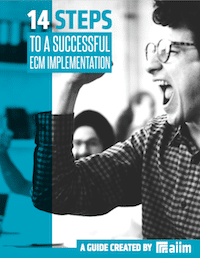The AIIM Blog
Keep your finger on the pulse of Intelligent Information Management with industry news, trends, and best practices.
One of the things I find interesting when I have conversations about the potential business impact of social technologies is the business person who says something like, "I have too much information coming at me right now. And besides, we already have a way for people to connect together, and it works perfectly well, and it's called email."
Share
Automation | Document Management | Paperless Office
How do you do more with less? Reduce your reliance on paper processes and start automating your workflow? Can you really create a paperless office? Why has this been a pipe dream until now?
Share

Making an ECM implementation successful requires planning and attention to detail. The best way to create the right solution is to identify organizational goals and priorities. Learn how to manage a successful implementation in our free guide.
No professional is an island. We are always engaged in some form of collaboration, whether we are working with colleagues, customers, or partners. As AIIM members know, one of the most visible ways that we collaborate is on documents. We all work together to create budgets, improve presentations, and build sales proposals.
Share
Electronic Records Management (ERM) | Enterprise Content Management (ECM) | Intelligent Information Management (IIM)
Myth # 1. Records Management starts when the boxes of files go offsite. Reality: Records Management is a discipline that starts when a record – paper or electronic – is actually created. By waiting until a record is no longer active to begin tracking its movement and access, companies are missing an opportunity to make the record accessible, authentic, and reliable. These characteristics of a record are required by the courts and government auditors. So if you don’t recognize this early on, you face a “pay me now or pay me later” scenario if your company becomes involved in litigation and has to gather responsive materials. In “pay me now,” you take the necessary time to manage records correctly throughout their lifecycle. In “pay me later,” you spend significantly more time and expense gathering case-related materials with a greatly increased risk of incurring penalties and sanctions.
Share
I enjoyed a conversation with Deb LaVoy and Scott Bowen from OpenText at the Enterprise 2.0 conference. I like their concept of "purpose-driven teams" in the context of social and Enterprise 2.0 technologies. As a community I am glad to see we are finally moving beyond the first wave of social technologies as something "cool" and somehow bolted on to the business independent of existing processes. We are starting to view these technologies as enablers of the business; something to be embedded in every process rather than something that stands independent of business processes.
Share
Myth #1: It’s Social Reality: The first thought that goes through senior manager’s minds when they hear “Social Media” is I don’t want my employees’ friending people on Facebook all day. I think there is an image of the technology that gets created in our minds because we use the word “Social." This image is propagated by many of the vendors in the market who are bringing Web 2.0 tools to the enterprise with little understanding of how a business functions. Everyone wants to recreate Twitter and Facebook inside the firewall. Entrepreneurs see themselves as the next Zuckerberg, and they haven’t even had an original thought yet. No one seems to step back and ask is this what the enterprise really needs? My belief is that you will truly see Enterprise Social take off when it gets focused on business activities and tasks and moves away from building networks and sharing what we had to eat for lunch. Wikis, blogs, discussion boards are great ways to exchange thoughts and ideas. When we begin to focus these tools on solving business problems, they will become invaluable, but it’s not going to seem very “Social.”
Share